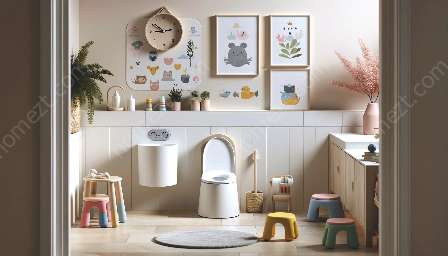As a crucial milestone in a toddler's development, potty training can sometimes be a challenging journey for both children and parents. Nighttime potty training, in particular, requires patience, commitment, and understanding. In this article, we will explore the best practices, tips, and strategies to successfully introduce nighttime potty training to toddlers. Additionally, we will discuss the importance of creating a supportive environment in the nursery & playroom to facilitate this process.
Understanding Nighttime Potty Training
Nighttime potty training refers to the process of teaching toddlers to stay dry throughout the night without needing to use diapers or waking up for bathroom visits. While daytime potty training focuses on recognizing and responding to the body's signals during waking hours, nighttime potty training requires a different approach, as it involves managing bladder control during sleep.
It's important to note that every child is unique, and readiness for nighttime potty training varies. Some toddlers may naturally achieve nighttime bladder control earlier, while others may take longer to reach this developmental milestone.
Tips for Successful Nighttime Potty Training
1. Establish a Routine: Consistency is key when it comes to nighttime potty training. Create a bedtime routine that includes a designated bathroom break before bed to encourage emptying the bladder.
2. Limit Fluid Intake: Minimize your toddler's liquid consumption in the hours leading up to bedtime to reduce the likelihood of accidents during the night. However, ensure that your child remains adequately hydrated throughout the day.
3. Use Protective Bedding: Invest in waterproof mattress protectors and layers of sheets to simplify the cleanup process in case of accidents. This can also provide reassurance to both the child and the parent, reducing anxiety around potential nighttime accidents.
4. Encourage Independence: Help your toddler feel empowered by providing easy-to-reach nightlights, step stools, and training pants or underwear that they can manage on their own if they need to use the bathroom during the night.
Creating the Perfect Nursery & Playroom Environment
Ensuring a supportive environment in the nursery & playroom can significantly contribute to the success of nighttime potty training. Here are a few strategies to consider:
1. Comfortable and Accessible Bathroom: Make the bathroom a welcoming and accessible space for your toddler. Consider installing a soft night light to guide them during nighttime bathroom visits.
2. Thoughtful Room Layout: Organize the nursery & playroom in a way that encourages your toddler to independently access the bathroom. Keep pathways clear and consider using storage solutions that are easily manageable for a young child.
3. Positive Reinforcement: Celebrate small victories and efforts made by your toddler towards nighttime potty training. Create a positive and encouraging atmosphere that reinforces their progress.
Conclusion
By implementing these tips and creating a supportive environment in the nursery & playroom, parents can navigate nighttime potty training with patience and understanding. It's essential to remember that each child progresses at their own pace, and setbacks are a natural part of the learning process. With the right strategies, nighttime potty training can become a successful and rewarding experience for both toddlers and their parents.


